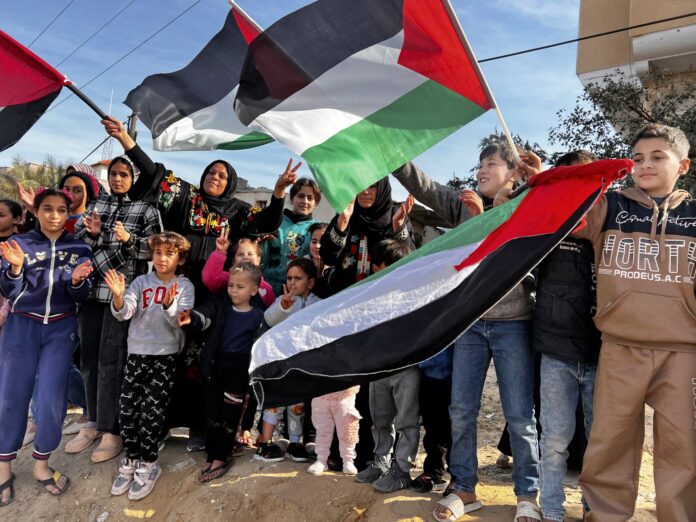A ceasefire deal between Israel and the Palestinian group Hamas has gone into effect in Gaza, allowing more than 2 million Palestinians in the enclave some respite after 15 months of devastating war.
The first six-week phase of the ceasefire agreement will see some of the Israeli captives held in Gaza released in exchange for Palestinian prisoners held by Israel, a gradual Israeli withdrawal to Gaza’s borders with Israel, and a huge increase in access for humanitarian aid.
It is hoped that the first phase will pave the way for the second and third phases, which will lead to the release of all captives and a permanent ceasefire.
The path to this latest agreement has been long and full of false starts. Here’s a look at the journey to this deal since the war started on October 7, 2023.
The first truce
After more than six weeks of fighting that destroyed extensive areas of Gaza and killed thousands, Israel and Hamas agreed to a four-day truce on November 21, 2023.
In the weeks since Hamas fighters had attacked southern Israel on October 7, 2023, and killed 1,200 people, the Israeli army had relentlessly bombarded Gaza with air and ground attacks, killing more than 14,000 Palestinians, mostly women and children.
Additionally, an estimated 1.7 million Palestinians had been displaced and forced by the Israeli army to flee to the southern areas of the Strip.
After weeks of hectic negotiations led by Qatar and multiple instances when a deal appeared on the horizon before falling apart, Israeli Prime Minister Benjamin Netanyahu called a meeting of his cabinet, which then voted to approve a truce deal.
About 250 captives were taken by Hamas and other Palestinian groups following the attack on October 7. As part of the November deal, 110 were freed.
Israel released more than 240 Palestinian prisoners, all of them women and children.
The truce was extended to seven days, but Netanyahu made it clear that Israel was not ending its war on Gaza and that the halt in fighting was only temporary. Israel resumed its war on Gaza on December 1, 2023.

International pressure
As Israel’s war on Gaza intensified, protests broke out around the globe.
Notably, university students in the United States held campus protests and sit-ins that grabbed global attention.
As the war continued, a few European nations officially recognised the state of Palestine, including Ireland, Spain and Norway.
South Africa also filed a genocide case against Israel at the International Court of Justice (ICJ) which was later backed by at least 14 countries, including Belgium, Colombia, Turkiye, Egypt, Chile and Spain.
Negotiations continue
In May 2024, as the war on Gaza entered its eighth month, hopes that a ceasefire might be reached were amplified as talks progressed.
In Cairo, Egyptian and Qatari officials worked with the Americans to find an agreement – then, Hamas leader Ismail Haniyeh said on May 6 that his group had accepted a proposal. Palestinians started to celebrate in the streets of Gaza.
That agreement, which would take place over three stages, stated that Hamas would release 33 Israeli captives in exchange for hundreds of Palestinian prisoners held in Israeli prisons over the course of 42 days. In the second phase, the Israeli army would fully withdraw from Gaza.
Israel, however, said it had not agreed to the terms of the ceasefire. Soon after, Israel launched an invasion of Rafah in southern Gaza.
Then in late May, US President Joe Biden said Israel had agreed to an ‘enduring ceasefire proposal’. But Netanyahu later rejected the plan and carried on the war.
Lebanon war
Israel and Hezbollah began attacking each other on October 8, 2023, as the Lebanese group said it was firing on Israel in solidarity with Gaza. On September 23, 2024, Israel intensified its attacks on Lebanon, killing more than 550 people in a single day. The attack came just a few days after the notorious pager and walkie-talkie attacks, and a few days before the assassination of Hezbollah’s longtime leader, Hassan Nasrallah.
A few days later, on October 1, 2024, Israel invaded south Lebanon.
Analyst Hamzé Attar told Al Jazeera that he believes Israel’s objectives in Gaza were achieved in early 2024 but the war was prolonged to execute attacks on Hezbollah in Lebanon.
A ceasefire was announced on November 27 that would see Hezbollah pull back its military infrastructure north of the Litani River and the Lebanese Armed Forces deploy to south Lebanon. The ceasefire agreement also states that Israeli troops should withdraw from south Lebanon before the 60-day ceasefire period ends.
Israeli troops are still present in border towns and are destroying homes and villages before withdrawing.
ICJ warrants
In November 2024, the ICJ issued arrest warrants for Netanyahu and Israel’s former defence minister, Yoav Gallant, for committing alleged war crimes in Gaza.
Many states said they would respect the court’s decision, though the US rejected the ruling and some officials threatened the court.
Trump enters the fray
On December 2, US President-elect Donald Trump posted to social media that there would be “hell to pay” if the captives in Gaza were not freed before he came to office. He repeated the demands later in December and again in early January.
Regional negotiations, including for ceasefires in Gaza and Lebanon, were reportedly coordinated between the Biden administration and some of the incoming officials from Trump’s new administration.
A deal is reached
On January 15, negotiators reportedly reached a deal after 15 months of war in which at least tens of thousands of Palestinians were killed. Some estimates put the death toll at more than 100,000.
An Israeli cabinet meeting approved the deal on Saturday, despite opposition from far-right ministers.
The ceasefire was due to begin at 8:30am local time (06:30GMT) on Sunday, January 19. Shortly before this time, Netanyahu issued a statement saying it would not start until Hamas provided the names of the first three Israeli captives to be released. Hamas attributed the delay in handing over the names to “technical field reasons”.
After Hamas released the names, the ceasefire came into effect at 11:15am local time (09:15GMT)
Much like the deal proposed in May, this ceasefire is set to roll out in three phases. The first stage will last 42 days as Israeli forces pull out of Gaza.
The Israeli military should also withdraw from populated areas of Gaza, allowing Palestinians to return to neighbourhoods throughout the enclave as a surge in humanitarian aid is allowed through. The United Nations and other bodies and organisations have accused the Israelis of blocking aid into Gaza for the better part of the last year.
Throughout the various negotiations, US officials often laid the blame on Hamas for failing to agree to the terms of a ceasefire agreement. However, in the run-up to the agreement, Israel’s National Security Minister Itamar Ben-Gvir claimed that he had repeatedly blocked ceasefire deals over the last 15 months.


